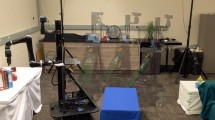Abstract
This paper addresses the problem of building large-scale geometric maps of indoor environments with mobile robots. It poses the map building problem as a constrained, probabilistic maximum-likelihood estimation problem. It then devises a practical algorithm for generating the most likely map from data, along with the most likely path taken by the robot. Experimental results in cyclic environments of size up to 80×25 m illustrate the appropriateness of the approach.
Similar content being viewed by others
Explore related subjects
Discover the latest articles, news and stories from top researchers in related subjects.References
Borenstein, J., Everett, B., and Feng, L. 1996. Navigating Mobile Robots: Systems and Techniques, Peters: Wellesley, MA.
Buhmann, J., Burgard, W., Cremers, A.B., Fox, D., Hofmann, T., Schneider, F., Strikos, J., and Thrun, S. 1995. The mobile robot Rhino. AI Magazine, 16:31-38.
Burgard, W., Cremers, A.B., Fox, D., Haehnel, D., Lakemeyer, G., Schulz, D., Steiner, W., and Thrun, S. 1998. In Proceedings of the AAAI National Conference on Artificial Intelligence, forthcoming.
Burgard, W., Fox, D., Hennig, D., and Schmidt, T. 1996. Estimating the absolute position of a mobile robot using position probability grids. In Proceedings of the 13th National Conference on Artificial Intelligence, AAAI Press: Menlo Park, CA, MIT Press, pp. 896-901.
Burgard, W., Fox, D., and Hennig, D. 1997. Fast grid-based positiontracking for mobile robots. In Proceedings of the 21th German Conference on Artificial Intelligence, Springer Verlag: Berlin, pp. 289-300.
Chatila, R. and Laumond, J.-P. 1985. Position referencing and consistent world modeling for mobile robots. In Proceedings of the 1985 IEEE International Conference on Robotics and Automation, pp. 138-145.
Choset, H. 1996. Sensor based motion planning: The hierarchical generalized voronoi graph. Doctoral dissertation, California Institute of Technology.
Dempster, A., Laird, A., and Rubin, D. 1977. Maximum likelihood from incomplete data via the EM algorithm. Journal of the Royal Statistical Society, Series B, 39:1-38.
Elfes, A. 1989. Occupancy grids: A probabilistic framework for robot perception and navigation. Doctoral dissertation, Department of Electrical and Computer Engineering, Carnegie Mellon University.
Fox, D., Burgard, W., and Thrun, S. 1997. A hybrid collision avoidance method for mobile robots. Internal Report, Universität Bonn, Institut für Informatik III, Bonn, Germany.
Gutmann, J.-S. 1996. Vergleich von Algorithmen zur Selbstlokalisierung eines mobilen Roboters. University of Ulm, Ulm, Germany, Master's Thesis.
Kaelbling, L., Cassandra, A., and Kurien, J. 1996. Acting under uncertainty: Discrete bayesian models for mobile-robot navigation. In Proceedings of the IEEE/RSJ International Conference on Intelligent Robots and Systems, pp. 963-972.
Kalman, R.E. 1960. A new approach to linear filtering and prediction problems. Transactions ASME, Journal of Basic Engineering, 82:35-45.
King, S. and Weiman, C. 1990. Helpmate autonomous mobile robot navigation system. In Proceedings of the SPIE Conference on Mobile Robots, Boston, MA, vol. 2352, pp. 190-198.
Koenig, S. and Simmons, R. 1996. Passive distance learning for robot navigation. In Proceedings of the 13th International Conference on Machine Learning, Morgan Kaufmann: San Mateo, CA, pp. 266-274.
Kuipers, B. and Byun, Y.-T. 1991. A robot exploration and mapping strategy based on a semantic hierarchy of spatial representations. Journal of Robotics and Autonomous Systems, 8:47-63.
Leonard, J., Durrant-Whyte, H., and Cox, I. 1992. Dynamic map building for an autonomous mobile robot. International Journal of Robotics Research, 11:89-96.
Lopez, M., Lopez de Mantaras, R., and Sierra, C. 1997. Incremental map generation by low cost robots based on possibility/necessity grids. In Proceedings of the 13th International Conference on Uncertainty in AI, Providence, RI, pp. 351-357.
Lu, F. and Milios, E. 1997. Globally consistent range scan alignment for environment mapping. Autonomous Robots, 4:333-349.
Matarić, M. 1994. Interaction and intelligent behavior. Tech. Rep. AI-TR-1495, Massachusetts Institute of Technology, Artificial Intelligence Laboratory, Cambridge, MA.
Matarić, M.J. 1997. Reinforcement learning in the multi-robot domain. Autonomous Robots, 4(1):73-83.
Moravec, H.P. 1988. Sensor fusion in certainty grids for mobile robots. AI Magazine, 9:61-74.
Nourbakhsh, I., Powers, R., and Birchfield, S. 1995. DERVISH: An office-navigating robot. AI Magazine, 16:53-60.
Oore, S., Hinton, G., Dudek, G. 1997. A mobile robot that learns its place. Neural Computation, 9:683-699.
Parker, L.E. 1996. On the design of behavior-based multi-robot teams. Journal of Advanced Robotics, 10(6).
Rabiner, L. and Juang, B. 1986. An introduction to hidden Markov models. IEEE ASSP Magazine.
Rencken, W. 1993. Concurrent localisation and map building for mobile robots using ultrasonic sensors. In Proceedings of the IEEE/RSJ International Conference on Intelligent Robots and Systems, Yokohama, Japan, pp. 2129-2197.
Shatkay, H. and Kaelbling, L. 1997a. Learning topological maps with weak local odometric information. In Proceedings of the 15th International Joint Conference on Artificial Intelligence, Morgan Kaufmann: San Mateo, CA, pp. 920-927.
Shatkay, H. and Kaelbling, L. 1997b. Learning hidden Markov models with geometric information. Tech. Rep. CS-97-04, Brown University, Computer Science Department, Providence, RI.
Simmons, R. and Koenig, S. 1995. Probabilistic robot navigation in partially observable environments. In Proceedings of the 14th International Joint Conference on Artificial Intelligence, Morgan Kaufmann: San Mateo, CA, pp. 1080-1087.
Thrun, S. 1993. Exploration and model building in mobile robot domains. In Proceedings of the International Conference on Neural Networks, IEEE Neural Network Council, San Francisco, CA, pp. 175-180.
Thrun, S. 1998a. Learning metric-topological maps for indoor mobile robot navigation. Artificial Intelligence, 99(1):21-77.
Thrun, S. 1998b. Bayesian landmark learning for mobile robot localization. Machine Learning, forthcoming.
Thrun, S., Bücken, A., Burgard, W., Fox, D., Fröhlinghaus, T., Hennig, D., Hofmann, T., Krell, M., and Schimdt, T. 1998. Map learning and high-speed navigation in RHINO. In AI-based Mobile Robots: Case Studies of Successful Robot Systems, D. Kortenkamp, R. Bonasso, and R. Murphy (Eds.), MIT Press: Cambridge, MA, pp. 21-52.
Yamauchi, B. and Beer, R. 1996. Spatial learning for navigation in dynamic environments. IEEE Transactions on Systems, Man, and Cybernetics—Part B: Cybernetics, Special—Issue on Learning Autonomous Robots, also available at http://www.aic.nrl.navy.mil/~yamauchi/.
Author information
Authors and Affiliations
Rights and permissions
About this article
Cite this article
Thrun, S., Burgard, W. & Fox, D. A Probabilistic Approach to Concurrent Mapping and Localization for Mobile Robots. Autonomous Robots 5, 253–271 (1998). https://doi.org/10.1023/A:1008806205438
Issue Date:
DOI: https://doi.org/10.1023/A:1008806205438




